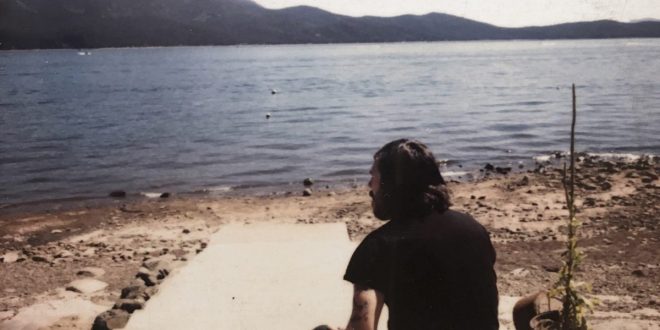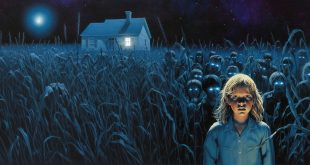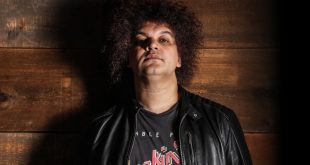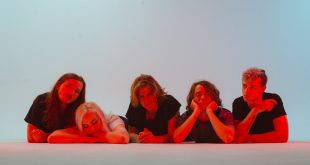Kurt Travis is a singer-songwriter based out of Sacramento, California. Best known for his former fronting of post-hardcore bands Dance Gavin Dance and A Lot Like Birds, and current band Royal Coda, Travis continues to boost his profile as a solo artist. He had begun this endeavor in the early 2010s, releasing three acclaimed efforts in 2012’s Wha Happen? EP, and two full-length albums – one self-titled, and its follow-up, Everything Is Beautiful – which were subsequently released over a two-year span. Now, after half a decade lapse, Travis is ready to unveil his third full-length album, There’s A Place I Want To Take You, slated for May 17th.
Upon the album’s release, Travis will embark on an accompanying tour that lasts until mid-June. I had the pleasure of speaking with Kurt about his formative experiences, the challenge of earning recognition as a solo artist, as well as what he took away from the process of creating his latest album.
ME: What do you enjoy most about playing live these days?
Kurt: Pretty much everything man! Playing live is one of the best parts about going on tour. Some things about touring, like not being able to see your loved ones, or having to sleep in weird areas, aren’t so fun. But I think being able to play new songs is another favorite part – these songs that I’ve held onto for so long and haven’t given a chance until now. It’s taken me at least three years before I completed the record, so it’s been a long time comin’.
ME: The fans must love you for it, too.
Kurt: Yeah. I always try to be down to earth with my fans, because I’m not playing these huge venues or anything, just 200-cap venues. It’s not too bad. I can go out and say ‘what up,’ you know?
ME: That’s good. When you were growing up, what kinds of influences shaped your musicianship?
Kurt: My family, on my mom’s side, is very musical. Her father was a Frank Sinatra-style lounge singer, so he loves to sing. We would go on camping trips when I was a kid and sing around the fire. My uncles all knew how to play guitar, drums, and bass. When I was about 13, I was gifted a guitar for my birthday from my uncle Wes, and I just really took to it.
I would say my family shaped my musical influences. I really looked up to my cousins Steve and Bob. They lived close by us in our neighborhood, just across the street from us. Pretty much whatever they’d listen to, I’d listen to. I’d listen to the radio a lot; there’s a station, The Eagles – 96.9, over here. We’d also listen to 101.1 which is the R&B and soul station. In general, it came down to my surroundings, environment, and family.
ME: You were in an early incarnation of Dance Gavin Dance, you had A Lot Like Birds, and you have your current band, Royal Coda. When it comes to your solo material, would you consider that to be a clean slate, or an expansion of all these bands?
Kurt: The solo career was kind of my management’s idea. At the time, I was in A Lot Like Birds. I had some songs of my own I was kicking around, and I talked to Doghouse Records about putting out an EP. For me, this was more of a way to breathe fresh life into each genre. When we were in A Lot Like Birds, we were touring six or seven months out of the year. We had a strict regimen while on tour, in that we had to be very, very frugal. In the band, we would give ourselves four dollars every other day, we’d sleep on gross floors and just crash at other people’s houses – whatever we could do just to save a buck. I didn’t complain, and I actually enjoyed that time, but at one point, I was like, “Yeah, I think I wanna do my own stuff.” That’s how it all began.
A Lot Like Birds was really chaotic and had their own post-hardcore sound, and I wanted to do something outside of those parameters. Like I mentioned before, I felt that the solo stuff breathed new life into each project, because when I write as a solo artist, it’s much different than collaborating with others. My own stuff is more straightforward – it’s indie rock, and very vocal oriented, with many different elements. Pursuing that really kept things fresh for A Lot Like Birds and myself.
With the solo thing, I toured a bunch, too; I grinded it out. Let me tell you – it was really tough at first to get people to either acknowledge or understand me as a solo artist. Just as Kurt Travis, you know what I mean? It’s so difficult, using just that moniker, to get fans and people interested, as opposed to being in a band.
Even with that, I love the journey, and I approach my solo stuff and Royal Coda the same way. With Royal Coda, it’s an effort between me, Sergio, Joe, and Jason. As I do my solo stuff, it’s more independent — not stepping on anyone’s toes, and just channeling what I feel is supposed to happen. They’re two different monsters, but they’re really fun, and I feel like they fuel each other.
ME: Pulling all of that into your new solo album, There’s A Place I Want To Take You, how did that come about?
Kurt: Ever since Life Is Beautiful, I wanted to write a new full-length album. I think it’s taken me about five years to do it, although I could say that I wasn’t frivolously trying to finish it for the entirety of that time. I did record the damn thing three times (laughs)!
ME: Oh man, three times over.
Kurt: Yeah! The first time I recorded the album, it was with Tim Feerick, the bassist from Dance Gavin Dance. We knew it wasn’t going to be the finished product; we were just willing to get ideas down, and he would help me out in between tours. We took those songs, and Ben Rosett and I were working on them together for a while. When things didn’t turn out the way they did, I ended up re-recording the album again with Mike Watts in New York. It was a really interesting process trying to get this sucker down, but I’m so glad I did that with Watts because he and I worked on a lot of different harmonies that I wouldn’t have thought of, and just different things that wouldn’t conventionally fit into the record on the surface. I also re-wrote a lot of lyrics. Before I did the record, I would just play the songs live and sing whatever came out (laughs). On tour, some of the songs managed to take shape, so the record ended up having studio versions of some of the songs I’ve played live that the fans are already familiar with. As I worked more on the record, those songs would develop a whole lot, so I’m really thankful for Dominic Nastasi and Mike Watts helping me on this record.
ME: When you mention re-recording the whole album, it reminds me of Dave Grohl and Foo Fighters re-doing The Colour and the Shape.
Kurt: Yeah (laughs)! It’s a flawless record, though!
ME: Yup, it’s all worth it in the end.
Kurt: Exactly, and here’s another thing, too, man. As soon as the record is done, I immediately start hearing mistakes (laughs)! As soon as all the master tapes are in, and we plan to send them out, I’m like, “Wait! No! Oh Crap!” Once that record gets stamped, you’ll always pick up on mistakes in your baby, you know? But you try your best, and a lot of the time, those mistakes end up becoming endearing after a while.
ME: How was production handled for your new album?
Kurt: It was handled by two guys — Mike Watts and Dominic Nastasi. Mike has a lot of engineers working at his studio, but the one I like best is Dominic. He also worked with me on the Royal Coda album. They bring a lot to the table as a team, and they mixed and mastered the album as well. Dominic took a crack at a bunch of tracks and so did Mike, and we just kind of went down the line. The thing about mixing is that once you mix something, you’ll go back the next day and say, “Okay, it sounds great, but I want to hear ‘this’ more and ‘this’ less.” Little things like that. They were really helpful with going back and forth with my notes and updating these mixes. It didn’t take many revisions; like five or six, which isn’t too bad. That whole process was done at Voodoo with Mike Watts and Dominic Nastasi.
It’s crazy when you do this and the magic happens. When everything clicks, you’re like, “Okay, I’m not doing anything else, I’m gonna go straight back here,” because it’s a good atmosphere, you know? Voodoo’s like my spot. I can’t imagine recording anywhere else.
ME: For the lead track, “Too Much Space,” what inspired you to kick off the album with that song? I know it can sometimes be a difficult process.
Kurt: Yeah. For me, it was a little simpler — I just liked the intro to the song. When going through the batch of songs that I recorded, I always ended up on that one first, and then “Easy Peasy” second. I’m really just a creature of habit, and I gravitated toward “Too Much Space” a lot of the time. Also, in terms of marketing, I feel like, nowadays, kids don’t have the attention span like they used to. For that, you’d want to put your most heavy-hitting songs first. Then, to smooth out the album, you want to put your thinkers at the middle and toward the end. So, I put the songs I thought people would readily enjoy at the beginning, for fear of them getting bored, or something (laughs)! I think Sergio advised me to do that, too.
ME: You mentioned the second song, “Easy Peasy.” From what I’ve read, that song was simple on the surface, but you actually had a difficult time recording it.
Kurt: Yeah, I jinxed myself, basically (laughs)! It’s exactly what you said. Because the song is repetitive, I called it “Easy Peasy,” under the assumption that it would be easy to record. A lot of times, when you’re recording, you don’t have working titles for your songs, so you think of a random name as a place marker just so that you can talk to the engineer and everyone can understand you.
ME: I know exactly what you mean.
Kurt: Yeah (laughs)! There’s a lot of wacky names that are destroyed, and sometimes they get replaced by a lyric from the chorus. I like to do that because when I was younger, I’d write a song that was called like “November in my Soul,” or something; but nowhere in the song does it say that. That really does the artist a disservice, because their listeners end up really liking the song but can’t remember its name. If the song’s so cryptically metaphorical when you hear it in passing, and can’t recognize its actual title, then the artist is at quite a disadvantage.
At this point, now, I look for a lyric someone can really latch onto. Sometimes, there may be no lyrics anywhere on the CD jacket, so I want to make the song titles almost like they’re misheard. In fact, I did that for the song “Best Way.”
Anyway, I thought that “Easy Peasy” was going to be a song I could knock out right away and then move onto others that are more involved, but it ended up being incredibly difficult — not ‘Easy Peasy’ at all (laughs)! It was mainly the guitar line, because I’m primarily a vocalist.
ME: You have two songs on the album that you did with Andrés. What do you enjoy about working with him?
Kurt: If you’ve ever met Andrés, he’s just full of life — extremely creative, very funny, and I love that about him. He was in a band a long time ago called Terra Alive. They were pretty good, and I met them while on tour with A Lot Like Birds. They lived in the Bakersfield area and played a show with us in LA. We stayed at his house and had a good time. We really connected and kept in touch. Years later, I’m playing a random solo show with this guy Andrés. I forget his name, but I remember his band Terra Alive. During his performance, which is in my hometown — no lie — the audience just erupts and sings every lyric off the album. I’m like, “Who the hell is this guy?” As it turns out, I’d already met him, and we’d already knew each other, so it’s good that our friendship rekindled. We’ve been doing shows and tours together. He’s toured with Royal Coda, and with me as a solo artist, and we’ve just been the best of friends ever since. I think that was around four or five years ago. It’s awesome to be with a musician that I enjoy seeing and playing with. He has an awesome live show, his band is great, and we have the same booking agent, Donovan Melero.
ME: Ah, Don Melero from Hail the Sun. Cool!
Kurt: Yeah! Yeah…I love that guy. He’s been my agent ever since A Lot Like Birds, and he’s really shaped my career in getting me that success, man. Hats off to that guy; he’s a hard worker.
Andrés, too. He’s family, man. Like I mentioned, we’ve toured multiple times solo and with Royal Coda. He has a new album out as well. When all of this was going down and I decided to “re, re, re-record” the album, I knew I wanted a guest vocalist because I’ve never done that, and people loved it. I’m usually the guest vocalist for other people’s stuff, so it’s a real treat for everybody, so I told Andrés to jump on those couple songs. In “Too Much Space,” he has a smaller feature, but on “Hometown,” he sings a majority of the song. I can’t wait for that song to come out because I think people will really enjoy it! They really enjoy his style of singing and writing — like a Drake-esque rapping and singing. And he’s a very heart-on-his-sleeve sort of guy. I love his lyrics, too. They’re very literal, relatable, and what I like the most is that he’s not afraid to be vulnerable. He’s not afraid to be honest with people. Sometimes there are topics that are uncomfortable with people, and he’ll push the envelope and get people thinking no matter what.
ME: I like the general flow of the album. Sound-wise, it goes back to that 90s warmth and crunch that’s been missing in rock music for many years, so you guys nailed that.
Kurt: Oh man, that’s such an amazing observation. I hope Mike Watts gets to see this interview because he has a lot to do with that. We actually used a 1986 SSL console to really boost the sound of this record. You have no idea how many inebriated nights of Mike and me saying, “We’re not going to make this record sound like everybody else; we’ll make it sound real and raw,” and that’s what we did. I really hope this stands the test of time because you’re right. We are in the scene of polished production, triggered kick drums, and auto-tuned vocals. There is a place for that, and you can get away with using small amounts of each, but you have to make sure it sounds from the heart. The 90s feel — thank you so much for noticing that. That’s a compliment to me because when I was writing songs like “Tomorrow Will Be Fine,” I thought it sounded like a straight up Third Eye Blind song (laughs)! I think I even said in one of my interviews that you can literally sing “Can I Graduate” over that song. And it’s purposeful. I love 80s pop and 90s rock. Everything Is Beautiful has a lot of 80s influence like Joy Division and The Cure. But with this new record, you’re right, I’ve ushered myself into a mostly 90s vibe.
ME: After the thrice re-recording of the album, and everything in between, what have you learned from this experience?
Kurt: You can’t rush art. No matter how badly you want to put something out, if it’s not ready, you shouldn’t release it. Making this record, I really wanted to showcase how much I’ve matured as an artist — to not be scatterbrained, and to showcase a diverse, open spectrum of sounds. I wanted to incorporate throwback elements, but at the same time, implement a sound that’s unique and balanced. But in general, not rushing the process is the main thing I’ve learned. I’ve also had a lot of personal stuff in my life happen in the last year and a half. I don’t want to get into it, but it took a lot out of me emotionally. I’m excited to put this record out, but it’s also a therapeutic thing because I feel like I’m in a much better place now than I was then.
ME: Lastly, anything you’d like to say to your fans?
Kurt: I’m never going to stop. I know a lot of people have seen me discouraged, and it’s tough to keep going, especially since I’ve been touring for 18 years for the same 200 people (laughs)! But it’s a blessing, and a treat, that I get to do this with my life. I know it sounds cliché, but if it wasn’t for those people believing in me, I wouldn’t be able to do what I can do. I’m thankful for the support of this family of musicians I’ve surrounded myself with — Joseph Arrington, Sergio Medina, my high school buddy Jason Ellis — they’ve really helped me along the way and I love them very much. And my immediate family — my parents, brothers, sister — they’ve sacrificed so much for me, so I can do what I do. Yeah, friends, family, fans, I love them. Thank you!
Kurt Travis Socials:
 Music Existence Because of Music, We Exist
Music Existence Because of Music, We Exist




